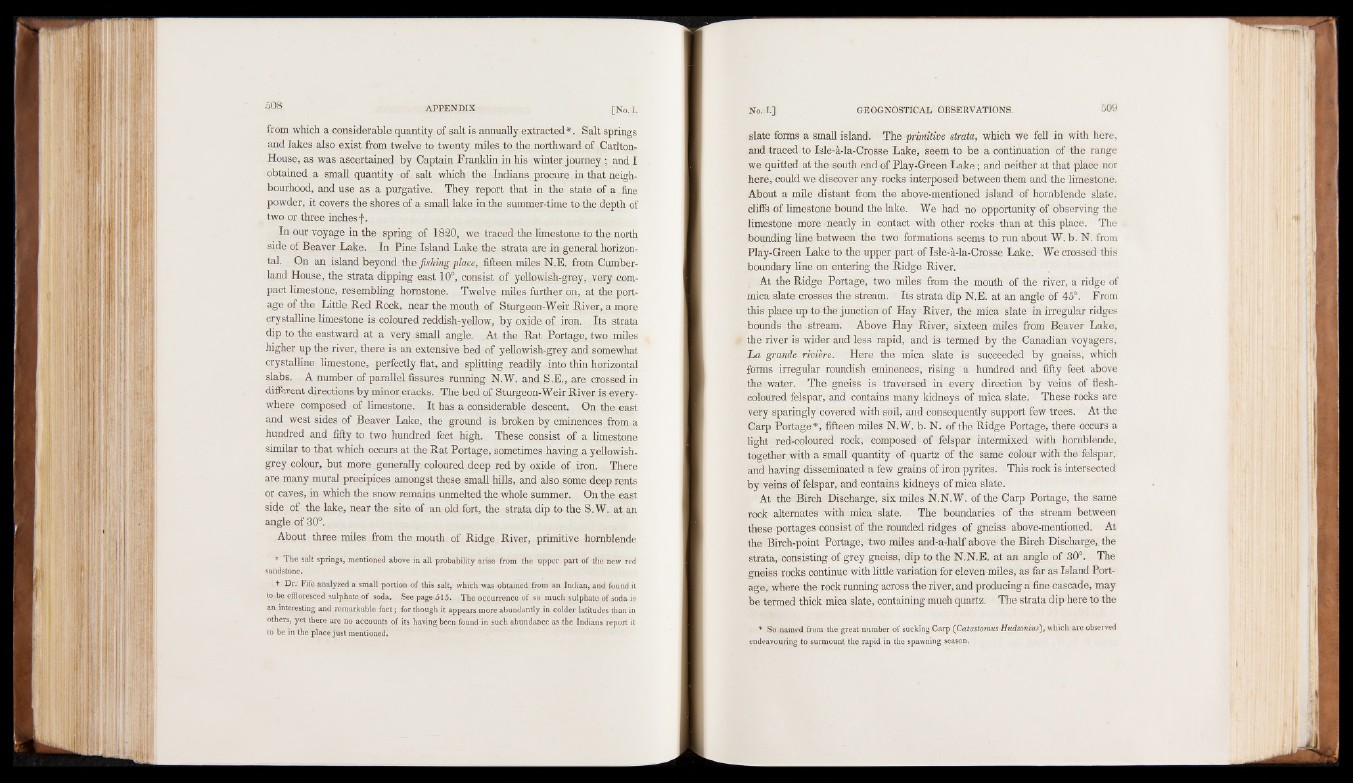
from which a considerable quantity of salt is annually extracted*. Salt springs
and lakes also exist from twelve to twenty miles to the northward of Carlton-
House, as was ascertained by Captain Franklin in his winter journey ; and I
obtained a small quantity of salt which the Indians procure in that neighbourhood,
and use as a purgative. They report that in the state of a fine
powder, it covers the shores of a small lake in the summer-time to the depth of
two or three inches j\
In our voyage in the spring of 1820, we traced the limestone to the north
side of Beaver Lake. In Pine Island Lake the strata are in general horizontal.
On an island beyond the fishing place, fifteen miles N.E. from Cumberland
House, the strata dipping east 10°, consist of yellowish-grey, very compact
limestone, resembling hornstone. Twelve miles further on, at the portage
of the Little Red Rock, near the mouth of Sturgeon-Weir River, a more
crystalline limestone is coloured reddish-yellow, by oxide of iron. Its strata
dip to. the eastward at a very small angle. At the Rat Portage, two miles
higher up the river, there is an extensive bed of yellowish-grey and somewhat
crystalline limestone, perfectly flat, and splitting readily into thin horizontal
slabs. A number of parallel fissures running N.W. and S.E., are crossed in
different directions by minor cracks. The bed of Sturgeon-Weir River is everywhere
composed of limestone. It has a considerable descent. On the east
and west sides of Beaver Lake, the ground is broken by eminences from a
hundred and fifty to two hundred feet high. These consist of a limestone
similar to that which occurs at the Rat Portage, sometimes Haying a yellowish-
grey colour, but more generally coloured deep red by oxide of iron. There
are many mural precipices amongst these small hills, and also some deep rents
or caves, in which the snow remains unmelted the whole summer. On the east
side of the lake, near the site of an old fort, the strata dip to the S.W. at an
angle of 30°.
About three miles from the. mouth of Ridge River, primitive hornblende
* The salt springs, mentioned above in all probability arise from the upper part of the new red
sandstone.
t Dr.' Fife analyzed a small portion of this salt, which was obtained from an Indian, and found it
to be effloresced sulphate of soda. , See page 515. The occurrence of so much sulphate of soda is
an interesting and .remarkable fact ; ;for though it appears more abundantly in colder latitudes than in
others, yet there are no accounts of its having been found in such abundance as the Indians report it
t'd be in the placé just mentioned.
slate forms a small island. The primitive strata, which we fell in with here,
and traced to Isle-k-la-Crosse Lake, seem to be a continuation of the range
we quitted at the south end of Play-Green Lake; a nd neither at that place nor
here, could we discover any rocks interposed between them and the limestone.
About a mile distant from the above-mentioned island of hornblende slate,
cliffs of limestone bound the lake. We had no opportunity of observing the
limestone more nearly in contact with other rocks than at this place. The
bounding line between the two formations seems to run about W. b. N. from
Play-Green Lake to the upper part of Isle-k-la-Crosse Lake. We crossed this
boundary line on entering the Ridge River.
At the Ridge Portage, two miles from- the , mouth of the river, a ridge of
mica slate crosses the stream. Its strata dip N.E. at an angle of 45°. From
this place up to the junction of Hay River, the mica slate in irregular ridges
bounds the stream. Above Hay River, sixteen miles from Beaver Lake,
the river is wider and less rapid, and is termed by the Canadian voyagers,
La grande riviere. Here the mica slate is succeeded by gneiss, which
forms irregular roundish eminences, rising a hundred and fifty feet above
the water. The gneiss is traversed in every direction by veins of flesh-
coloured felspar, and contains many kidneys of mica slate. These rocks are
very sparingly covered with soil, and consequently support few trees. At the
Carp Portage*, fifteen miles N.W. b. N. of the Ridge Portage, there occurs a
light red-coloured rock, composed of felspar intermixed with hornblende,
together with a small quantity of quartz of the same colour with the felspar,
and having disseminated a few grains of iron pyrites. This rock is intersected
by veins of felspar, and contains kidneys of mica slate.
At the Birch Discharge, six miles N.N.W. of the Carp Portage, the same
rock alternates with mica slate. The boundaries of the stream between
these portages consist of the rounded ridges of gneiss above-mentioned. At
the Birch-point Portage, two miles and-a-half above the Birch Discharge,, the
strata, consisting of grey gneiss, dip to the N.N.E. at an angle of 30°. The
gneiss rocks continue with little variation for eleven miles, as far as Island Portage,
where the rock running across the river, and producing a fine cascade, may
be termed thick mica slate, containing much quartz. The strata dip here to the
* So named from tlie great.number.of sucking Carp (Catastomus Hudsonius), which are observed
endeavouring to surmount the rapid in the spawning season.